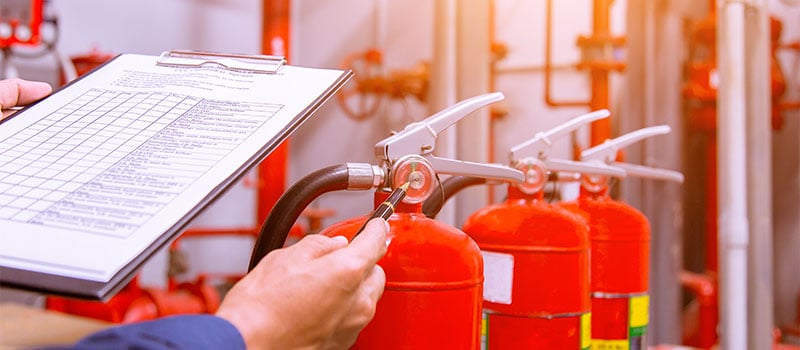Although the number of people dying in fires in the United States has trended down in recent decades, it’s still a significant cause of death with more than 3,500 fire deaths reported in 2016, according to the U.S. Fire Administration.
Most of these fire deaths occur in residential buildings, but the 96,800 fires in nonresidential buildings in 2016 led to 145 deaths, 1,550 injuries and more than $2 billion worth of damage. That includes 88 fatal work injuries caused by fires and explosions.
October 7-13 is Fire Prevention Week, so now is a great time to make sure your business is doing everything it can to prevent fires and be prepared for if they do happen. Employers should train employees about fire hazards and procedures to follow during a fire emergency, according to the Occupational Safety and Health Administration.
Here are some excellent questions to ask when checking your workplace’s fire safety, according to OSHA:
- Is your local fire department familiar with your facility, its location and specific hazards?
- If you have a fire alarm system, is it certified as required and tested annually?
- If you have interior standpipes and valves, are they inspected regularly?
- If you have outside private fire hydrants, are they flushed at least once a year and on a routine preventive maintenance schedule?
- Are fire doors and shutters in good operating condition?
- Are fire doors and shutters unobstructed and protected against obstructions, including their counterweights?
- Are fire door and shutter fusible links in place?
- Are automatic sprinkler system water control valves, air and water pressure checked periodically as required?
- Is the maintenance of automatic sprinkler systems assigned to responsible persons or to a sprinkler contractor?
- Are sprinkler heads protected by metal guards if exposed to potential physical damage?
- Is proper clearance maintained below sprinkler heads?
- Are portable fire extinguishers provided in adequate number and type and mounted in readily accessible locations?
- Are fire extinguishers recharged regularly with this noted on the inspection tag?
- Are employees periodically instructed in the use of fire extinguishers and fire protection procedures?

Here are some other things to consider from OSHA if your operation involves flammable and combustible materials:
- Are combustible scrap, debris and waste materials (oily rags, etc.) stored in covered metal receptacles and promptly removed from the worksite?
- Is proper storage practiced to minimize the risk of fire, including spontaneous combustion?
- Are approved containers and tanks used to store and handle flammable and combustible liquids?
- Are all connections on drums and combustible liquid piping, vapor and liquid tight?
- Are all flammable liquids kept in closed containers when not in use (e.g., parts cleaning tanks, pans, etc.)?
- Are bulk drums of flammable liquids grounded and bonded to containers during dispensing?
- Do storage rooms for flammable and combustible liquids have explosion-proof lights and mechanical or gravity ventilation?
- Is liquefied petroleum gas stored, handled and used in accordance with safe practices and standards?
- Are “NO SMOKING” signs posted on liquefied petroleum gas tanks and in areas where flammable or combustible materials are used or stored?
- Are liquefied petroleum storage tanks guarded to prevent damage from vehicles?
- Are all solvent wastes and flammable liquids kept in fire-resistant, covered containers until they are removed from the worksite?
- Is vacuuming used whenever possible rather than blowing or sweeping combustible dust?
- Are firm separators placed between containers of combustibles or flammables that are stacked one upon another to ensure their support and stability?
- Are fuel gas cylinders and oxygen cylinders separated by distance and fire-resistant barriers while in storage?
- Are fire extinguishers selected and provided for the types of materials in the areas where they are to be used?
- Are appropriate fire extinguishers mounted within 75 feet of outside areas containing flammable liquids and within 10 feet of any inside storage area for such materials?
- Are extinguishers free from obstructions or blockage?
- Are all extinguishers serviced, maintained and tagged at intervals not to exceed one year?

- Are all extinguishers fully charged and in their designated places?
- Where sprinkler systems are permanently installed, are the nozzle heads so directed or arranged that water will not be sprayed into operating electrical switchboards and equipment?
- Are safety cans used for dispensing flammable or combustible liquids at the point of use?
- Are all spills of flammable or combustible liquids cleaned up promptly?
- Are storage tanks adequately vented to prevent the development of excessive vacuum or pressure as a result of filling, emptying or atmosphere temperature changes?
- Are storage tanks equipped with emergency venting that will relieve excessive internal pressure caused by fire exposure?
- Are rules enforced in areas involving storage and use of hazardous materials?
These lists might seem overwhelming at first, but taking the time to evaluate your workplace’s fire prevention and preparedness is a worthwhile investment to prevent a possible tragedy. Providing proper exits, firefighting equipment and training help reduce the likelihood of fire deaths, injuries and property damage in the workplace.
.png?width=131&height=58&name=image%20(40).png)

